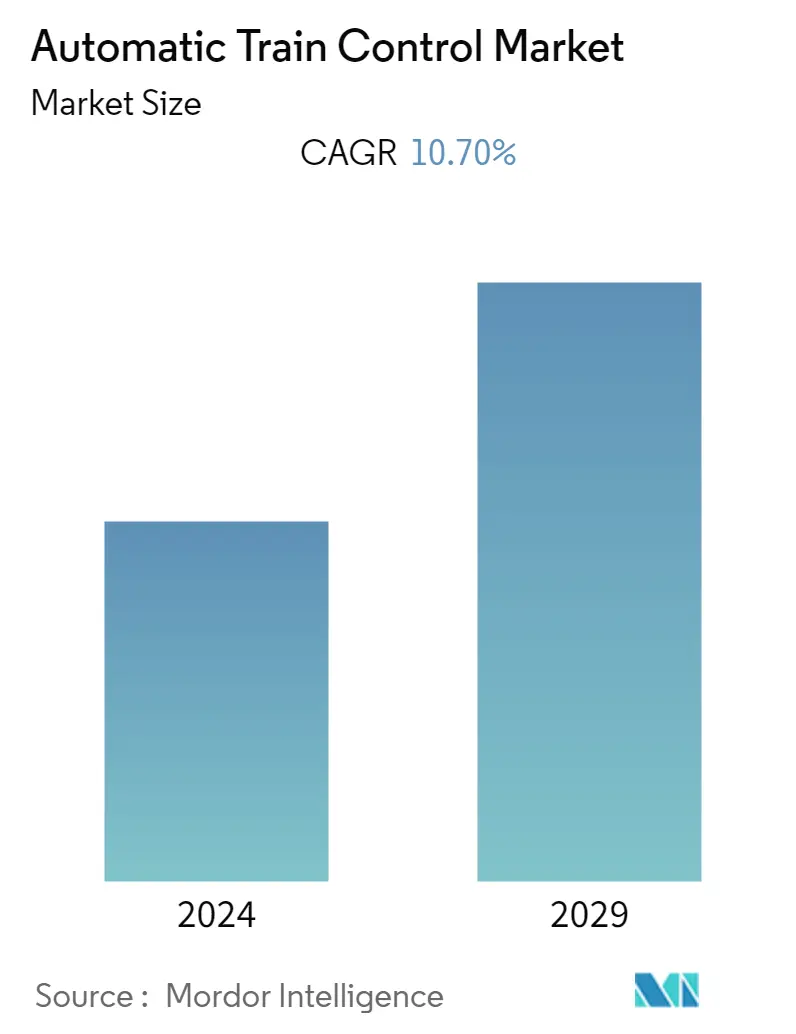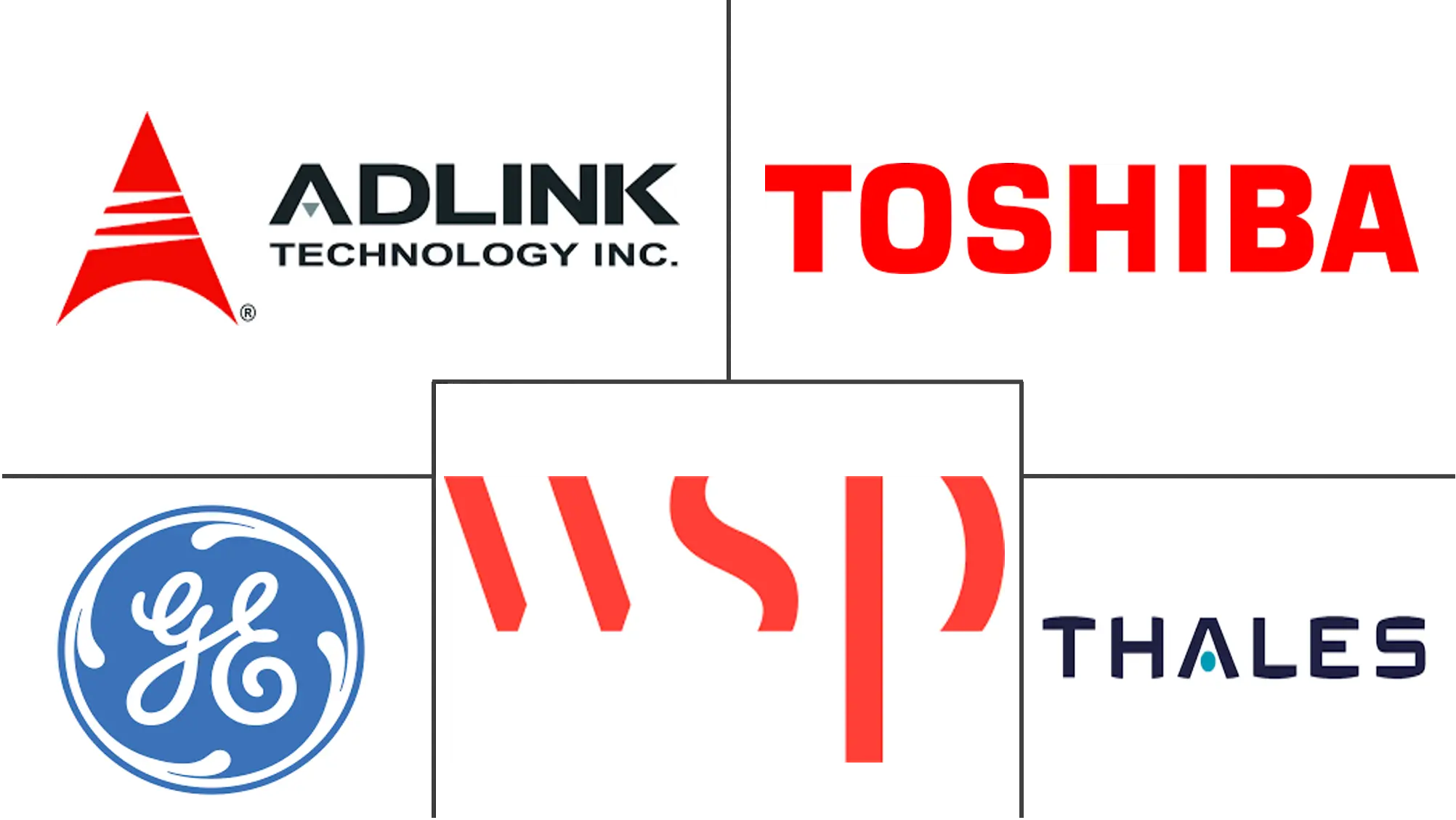Market Size of Automatic Train Control Industry

| Study Period | 2019 - 2029 |
| Base Year For Estimation | 2023 |
| CAGR | 10.70 % |
| Fastest Growing Market | Asia Pacific |
| Largest Market | North America |
| Market Concentration | Low |
Major Players
*Disclaimer: Major Players sorted in no particular order |
Automatic Train Control Market Analysis
The Automatic Train Control Market is expected to grow at a CAGR of 10.7% over the forecast period 2020 to 2025. Developing government assistance through providing funds for the building of technologically advanced trains pushes the automatic train control market globally. Furthermore, the increasing demand for pollution mitigation & rising demand for safety, hyper-urbanization, high demographic growth, technological advancements for improving passenger convenience, and increasing trend of smart cities are other fundamental factors propelling the global automatic train control market over the forecast period.
- Support and maintenance segment to expand at a higher growth rate during the forecast period. The support and maintenance services support the installed ATC system within the firm's infrastructure. The support and maintenance services include troubleshooting assistance, problem-solving, repairing, replacing old components, upgradation of the existing ATC solution, and testing scenario management, including facility inspection and training and round-the-clock support for ATC solutions.
- Growing standardization of rail signaling solutions is one of the most significant trends affecting the market today. Standardization enables suppliers to improve core, standards-based global architectures that both allow the interoperability required to meet local safety obligations and give a common, reliable platform for creating local solutions.
- Furthermore, the U.S. Department of Transportation (USDOT) is focusing on expanding rail lines in the Sonoma-Marin Area. For this project, FTA (Freight Transport Association) provided a USD 22.5 Mn fund to the rail ministry. China is projected to create a lucrative opportunity for the ATC market due to a Chinese company signing two rail projects with Brazil, to build two big-ticket railway-related infrastructure projects in eastern Brazil's Bahia state.
- For instance, countries like India, where Metro rail is going to be more than 70% of the railway market according to IBEF, have allowed 100% foreign direct investment in new rail sectors such as suburban corridors, high-speed train systems, and the freight line projects implemented through a public-private partnership.
- The US-based company SIL4 Systems develops onboard embedded control systems for enabling automatic train protection (ATP) and automatic train control (ATC). They offer a dual-purpose platform that houses an event recorder as well as allows for ATP and ATC. Further, they provide a range of vehicle communications such as dual WiFi, GPS, 3G, and dual Gigabit Ethernet (GbE) ports.
- Chinese suppliers are getting projects outside of China, while a group of smaller competitors is competing for pieces of each rail transport project, making for a crowded and competitive field. There is enormous potential for systems that meet the European Rail Traffic Management System (ERTMS) and Communication Based Traffic Control (CBTC) requirements.
- Nevertheless, the high initial investments and the necessity for regular maintenance may restrain the growth of the global automatic train control market in the coming years. However, the rising uptake of autonomous trains in densely populated Asian economies, like China and India, is expected to keep the automatic train control market running smoothly in the forthcoming years.
Automatic Train Control Industry Segmentation
Automatic train control (ATC) is a general category of train protection systems for railways that includes a speed control mechanism in reply to external inputs. ATC systems tend to combine multiple cab signaling technologies, and they use more granular deceleration patterns instead of the inflexible stops met with the older automatic train stop technology. ATC can also be applied with automatic train operation (ATO) and is usually deemed the safety-critical part of the system.
The International Association of Public Transport (UITP) Grades of Automation (GoA) system defines the degree of automation according to the level of responsibility assigned to the train control system. The report also includes;
- Automatic Train Protection (ATP) is the operation and all equipment accountable for basic safety; it avoids red signal overrunning, collisions, and beating speed limits by using brakes automatically. A line provided with ATP corresponds (at least) to a GoA1.
- Automatic Train Operation (ATO) assures incomplete or complete automatic train piloting and driverless functionalities. The ATO system displays all the functions of the driver, besides for door closing. The driver only necessitates closing the doors, and if the direction is clear, the train will automatically move to the next station. This corresponds to a GoA2.
- Automatic Train Control (ATC) works automatically normal signaller services such as route setting and train control. The ATO and the ATC systems collectively manage a train within a defined threshold of its timetable. There is no driver, and no staff designated to guide the train, corresponding to a GoA4.
- At Grade of Automation 4, ATC systems work within an overall signaling system with interlocking, automatic train supervision, track vacancy detection, and communication functions.
| By Service | |
| Consulting | |
| Integration & Deployment | |
| Support & Maintenance |
| By Technology | |
| Positive Train Control (PTC) | |
| Communication Based Train Control (CBTC) | |
| Automatic Train Control (ATC) | |
| Other Technologies |
| Geography | |
| North America | |
| Europe | |
| Asia-Pacific | |
| Latin America | |
| Middle East & Africa |
Automatic Train Control Market Size Summary
The Automatic Train Control (ATC) market is poised for significant growth, driven by factors such as government support for advanced train technologies, the need for pollution reduction, and the increasing emphasis on safety and urbanization. The market is further bolstered by technological advancements aimed at enhancing passenger convenience and the rising trend of smart cities. The support and maintenance segment is expected to experience rapid expansion, providing essential services like troubleshooting, upgrading, and round-the-clock support for ATC systems. Standardization of rail signaling solutions is a key trend, facilitating interoperability and creating a reliable platform for local solutions. The market is also witnessing substantial investments in regions like North America, where the implementation of Positive Train Control (PTC) systems is enhancing safety and efficiency in freight railroads.
The global ATC market is characterized by a competitive landscape with major players such as General Electric, Hitachi, Bombardier, Siemens, and others employing strategies like expansions, joint ventures, and partnerships to strengthen their market presence. The market's growth is supported by substantial investments in infrastructure projects, particularly in countries like China and India, where the adoption of autonomous trains is on the rise. Despite challenges such as high initial costs and the need for regular maintenance, the market is expected to thrive, driven by the increasing demand for efficient and safe rail transport solutions. The fragmented nature of the market, with numerous players vying for market share, underscores the dynamic and evolving nature of the ATC industry.
Automatic Train Control Market Size - Table of Contents
-
1. MARKET DYNAMICS
-
1.1 Market Overview
-
1.2 Market Drivers
-
1.2.1 Increasing Government Support through Providing Funds
-
1.2.2 Intense Demographic Growth and Increased Urbanization
-
1.2.3 Technological Progress Targeted to Passenger Convenience
-
-
1.3 Market Restraints
-
1.3.1 Necessity for Regular Maintenance
-
1.3.2 Complexities in Integrating ATC Solutions With Legacy Systems
-
-
1.4 Industry Attractiveness - Porter's Five Forces Analysis
-
1.4.1 Bargaining Power of Suppliers
-
1.4.2 Bargaining Power of Consumers
-
1.4.3 Threat of New Entrants
-
1.4.4 Threat of Substitutes
-
1.4.5 Intensity of Competitive Rivalry
-
-
1.5 Industry Value Chain Analysis
-
1.6 Assessment of Impact of Covid-19 on the Industry
-
-
2. MARKET SEGMENTATION**
-
2.1 By Service
-
2.1.1 Consulting
-
2.1.2 Integration & Deployment
-
2.1.3 Support & Maintenance
-
-
2.2 By Technology
-
2.2.1 Positive Train Control (PTC)
-
2.2.2 Communication Based Train Control (CBTC)
-
2.2.3 Automatic Train Control (ATC)
-
2.2.4 Other Technologies
-
-
2.3 Geography
-
2.3.1 North America
-
2.3.2 Europe
-
2.3.3 Asia-Pacific
-
2.3.4 Latin America
-
2.3.5 Middle East & Africa
-
-
Automatic Train Control Market Size FAQs
What is the current Automatic Train Control Market size?
The Automatic Train Control Market is projected to register a CAGR of 10.70% during the forecast period (2024-2029)
Who are the key players in Automatic Train Control Market?
ADLINK Technology Inc., WSP Global Inc., Thales Group, General Electric Company and Toshiba Corporation are the major companies operating in the Automatic Train Control Market.

